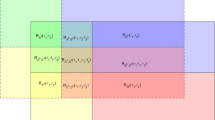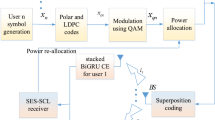Abstract
In this paper, we propose a novel distributed space-time block coding (STBC) scheme for multi-relay system. We consider the full-duplex cooperation which is more spectrally efficient than the half-duplex cooperation. In full-duplex mode, the new scheme requires relay nodes to stack only every two successive symbols for swapping. Thus, the end-to-end delay may be lower than that induced by orthogonal STBC and conventional quasi-orthogonal STBC (QOSTBC) schemes. We show the new distributed STBC is capable of achieving cooperative diversity by using multi-dimensional rotated signal constellation. Besides, due to the simpler maximum-likelihood metric compared to that of conventional QOSTBC, the code achieves a lower decoding complexity without any performance degradation. To furthermore reduce complexity, the fast sphere decoder is adopted for the proposed code. The proposed transmission scheme is evaluated and compared in terms of performance by simulation.



Similar content being viewed by others
References
Jing, Y., & Hassibi, B. (2006). Distributed space-time coding in wireless relay networks. IEEE Transactions on Wireless Communications, 5(12), 3524–3536.
Li, Z., & Xia, X. G. (2007). A simple alamouti space-time transmission scheme for asynchronous cooperative systems. IEEE Signal Processing Letters, 14(11), 804–807.
Jing, Y., & Jafarkhani, H. (2007). Using orthogonal and quasi-orthogonal designs in wireless relay networks. IEEE Transactions on Information Theory, 53(11), 4106–4118.
Jiang, H., Xing, X., Zhao, K., & Du, S. (2013). OFDM-based STBC with low end-to-end delay for full-duplex asynchronous cooperative systems. ETRI Journal, 35(4), 710–713.
Wang, B., Zhang, J., & Host-Madsen, A. (2005). On the capacity of mimo relay channels. IEEE Transactions on Information Theory, 51(1), 29–43.
Laneman, J. N., Tse, D. N. C., & Greogory, W. W. (2004). Cooperative diversity in wireless networks: Efficient protocols and outage behavior. IEEE Transactions on Information Theory, 50(12), 3062–3080.
Fang, W., Liu, F., Yang, F., Shu, L., & Nishio, S. (2010). Energy-efficient cooperative communication for data transmission in wireless sensor networks. IEEE Transactions on Consumer Electronics, 56(4), 2185–2192.
Zhang, Q., Jia, J., & Zhang, J. (2009). Cooperative relay to improve diversity in cognitive radio networks. IEEE Communications Magazine, 47(2), 111–117.
Liu, Y., Xia, X. G., & Zhang, H. (2012). Distributed space-time coding for full-duplex asynchronous cooperative communications. IEEE Transactions on Wireless Communications, 11(7), 2680–2688.
Riihonen, T., Werner, S., & Wichman, R. (2009). Optimized gain control for single-frequency relaying with loop interference. IEEE Transactions on Wireless Communications, 8(6), 2801–2806.
Riihonen, T., Werner, S., & Wichman, R. (2011). Hybrid full-duplex/half-duplex relaying with transmit power adaptation. IEEE Transactions on Wireless Communications, 10(9), 3074–3085.
Alabed, S. J., Paredes, J. M., & Gershman, A. B. (2011). A low complexity decoder for quasi-orthogonal space time block codes. IEEE Transactions on Wireless Communications, 10(3), 988–994.
Dalton, L. A., & Georghiades, C. N. (2005). A full-rate, full-diversity four-antenna quasi-orthogonal space-time block code. IEEE Transactions on Wireless Communications, 4(2), 363–366.
Su, W., & Xia, X. G. (2004). Signal constellations for quasi-orthogonal space-time block codes with full diversity. IEEE Transactions on Information Theory, 50(10), 2331–2347.
Jafarkhani, H. (2001). A quasi-orthogonal space-time block code. IEEE Transactions on Communications, 49(1), 1–4.
Golub, G. H., & Van Loan, C. F. (1996). Matrix computations (Vol. 3). Baltimore: Johns Hopkins University Press.
Damen, O., Chkeif, A., & Belfiore, J. C. (2000). Lattice code decoder for space-time codes. IEEE Communications Letters, 4(5), 161–163.
Viterbo, E., & Boutros, J. (1999). A universal lattice code decoder for fading channels. IEEE Transactions on Information Theory, 45(5), 1639–1642.
Damen, M. O., Abed-Meraim, K., & Belfiore, J. C. (2002). Diagonal algebraic space-time block codes. IEEE Transactions on Information Theory, 48(3), 628–636.
Tarokh, V., Jafarkhani, H., & Calderbank, A. R. (1999). Space-time block coding for wireless communications: Performance results. IEEE Journal on Selected Areas in Communications, 17(3), 451–460.
Author information
Authors and Affiliations
Corresponding author
Rights and permissions
About this article
Cite this article
Jiang, H., Cheng, H., Shen, L. et al. Distributed Cyclotomic QOSTBC with Low End-to-End Delay for Full-Duplex Multi-relay Systems. Wireless Pers Commun 82, 2611–2621 (2015). https://doi.org/10.1007/s11277-015-2368-4
Published:
Issue Date:
DOI: https://doi.org/10.1007/s11277-015-2368-4




